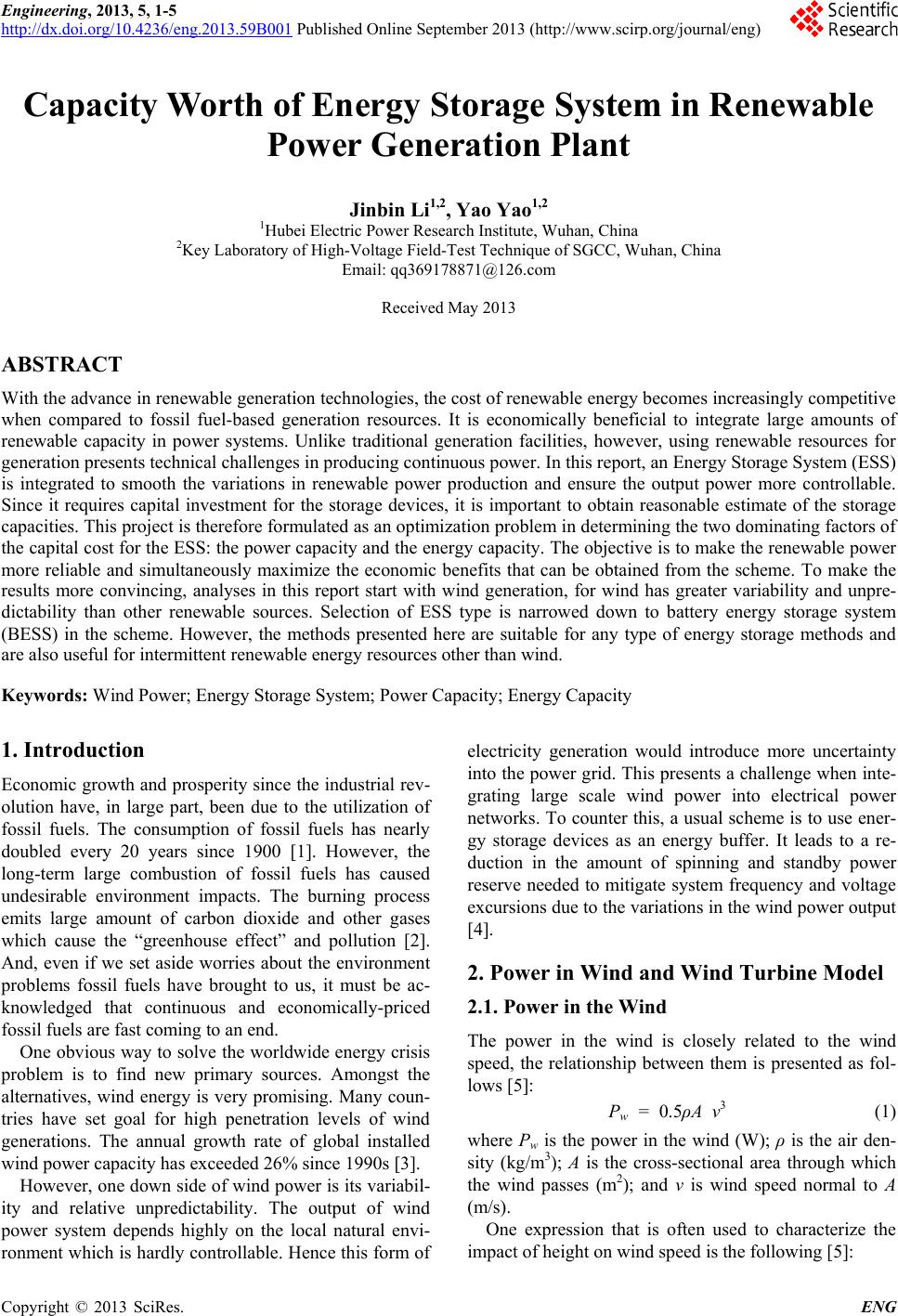
Engineering, 2013, 5, 1-5
http://dx.doi.org/10.4236/eng.2013.59B001 Published Online September 2013 (http://www.scirp.org/journal/eng)
Copyright © 2013 SciRes. ENG
Capacity Worth of Energy Storage System in Renewable
Power Gener a tion Pl an t
Jinbin Li1,2, Yao Yao1,2
1Hubei Electric Power Research Institute, Wuhan, China
2Key Laboratory of High-Voltage Field-Test Technique of SGCC, Wuhan, China
Email: qq369178871@126.com
Received May 2013
ABSTRACT
With the advance in renewable generation technologies, the cost of renewable energy becomes increasingly competitive
when compared to fossil fuel-based generation resources. It is economically beneficial to integrate large amounts of
renewable capacity in power systems. Unlike traditional generation facilities, however, using renewable resources for
generation presents technical challenges in producing continuous power. In this report, an Energy Storage System (ESS)
is integrated to smooth the variations in renewable power production and ensure the output power more controllable.
Since it requires capital investment for the storage devices, it is important to obtain reasonable estimate of the storage
capacities. This project is therefore for mulated as an optimization problem in determining the two dominating factors of
the capital cost for the ESS: the power capacity and the energy capacity. The objective is to make the renewable power
more reliable and simultaneously maximize the economic benefits that can be obtained from the scheme. To make the
results more convincing, analyses in this report start with wind generation, for wind has greater variability and unpre-
dictability than other renewable sources. Selection of ESS type is narrowed down to battery energy storage system
(BESS) in the scheme. However, the methods presented here are suitable for any type of energy storage methods and
are also useful for intermittent renewable energy resources other than wind.
Keywords: Wind Power; Energy Storage System; Power Capacity; Energy Capacity
1. Introduction
Economic growth and prosperity since the industrial rev-
olution have, in large part, been due to the utilization of
fossil fuels. The consumption of fossil fuels has nearly
doubled every 20 years since 1900 [1]. However, the
long-term large combustion of fossil fuels has caused
undesirable environment impacts. The burning process
emits large amount of carbon dioxide and other gases
which cause the “greenhouse effect” and pollution [2].
And, even if we set aside worries about the environment
problems fossil fuels have brought to us, it must be ac-
knowledged that continuous and economically-priced
fossil fuels are fast coming to an end.
One obvious wa y to solve the worldwide energy crisis
problem is to find new primary sources. Amongst the
alternatives, wind energy is very promising. Many coun-
tries have set goal for high penetration levels of wind
generations. The annual growth rate of global installed
wind power capacity has exceeded 26% since 1990s [3].
However, one down side of wind power is its variabil-
ity and relative unpredictability. The output of wind
power system depends highly on the local natural envi-
ronment which is hardly controllable. Hence this form of
electricity generation would introduce more uncertainty
into the power grid. This presents a challenge when inte-
grating large scale wind power into electrical power
networks. To counter this, a usual scheme is to use ener-
gy storage devices as an energy buffer. It leads to a re-
duction in the amount of spinning and standby power
reserve needed to mitigate system frequency and voltage
excursions due to the variations in the wind power output
[4].
2. Power in Wind and Wind Turbine Model
2.1. Power in the Wind
The power in the wind is closely related to the wind
speed, the relationship between them is presented as fol-
lows [5]:
Pw = 0.5ρA v3 (1)
where Pw is the power in the wind (W); ρ is the air den-
sity (kg/m3); A is the cross-sectional area through which
the wind passes (m2); and v is wind speed normal to A
(m/s).
One expression that is often used to characterize the
impact of height on wind speed is the following [5]: